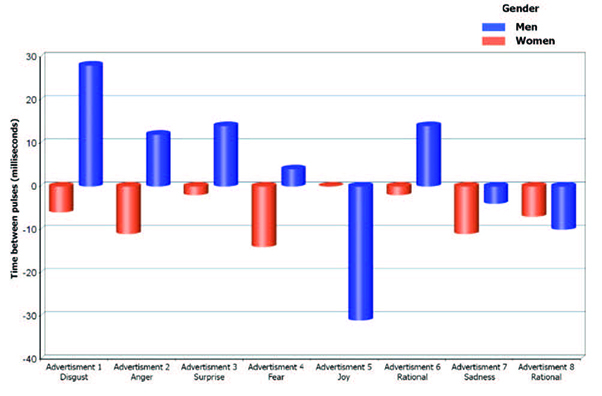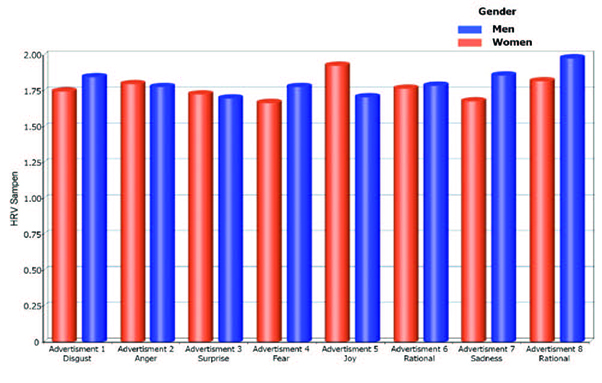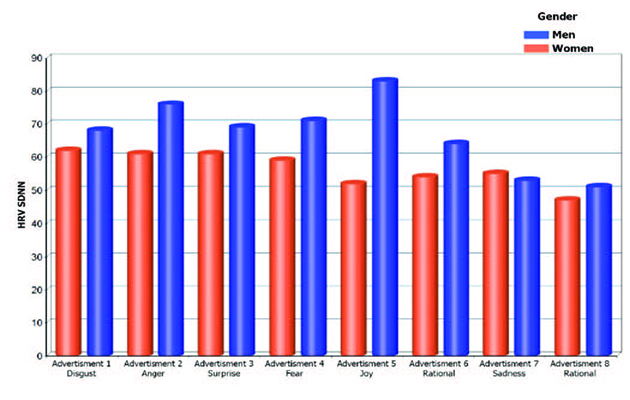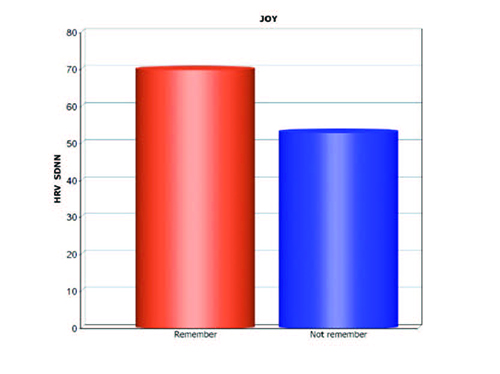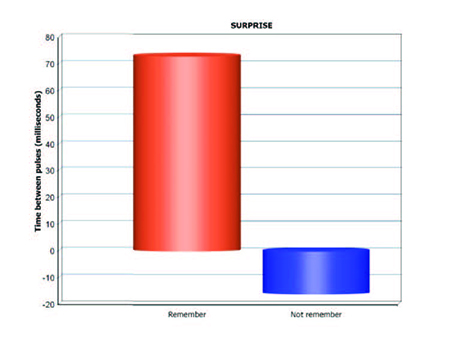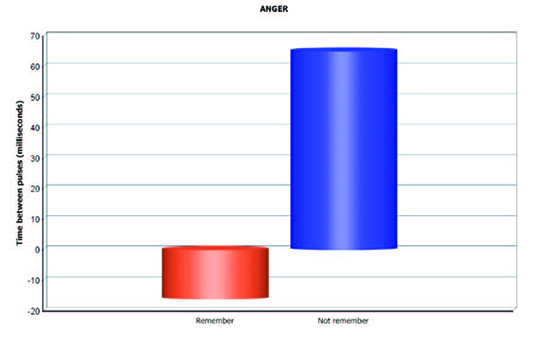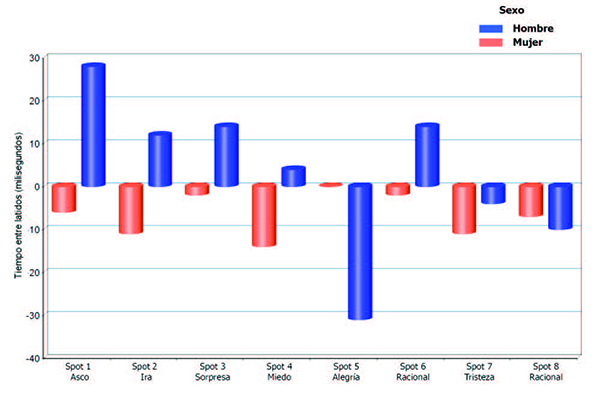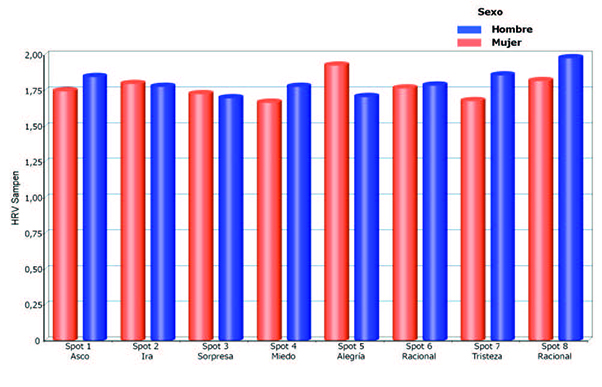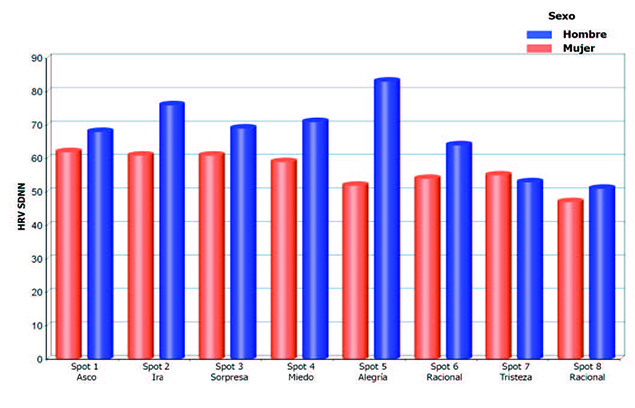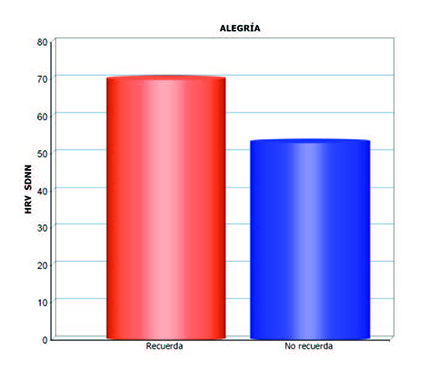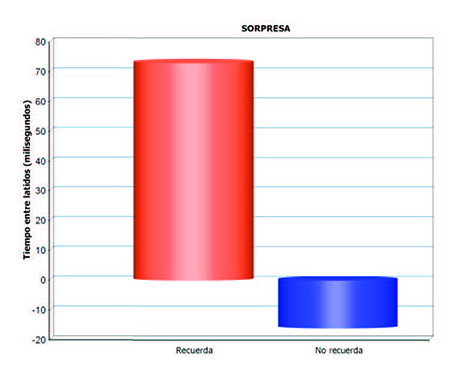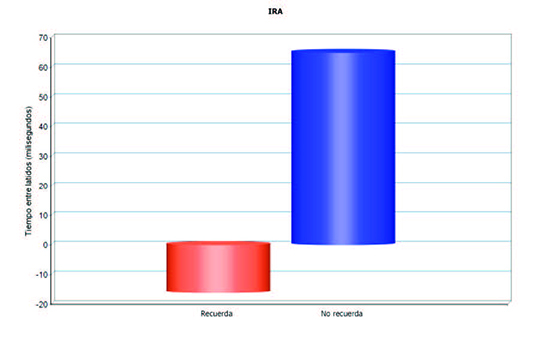(Created page with "<span style="color:#FFFFFF; background:#ffffcc"><span id="article_es"></span>Pulsa aquí para ver la versión en Español (ES)</span> ==== Abstract ==== Since...") |
m (Scipediacontent moved page Draft Content 848119328 to Baraybar-Fernandez et al 2017a) |
(No difference)
| |
Latest revision as of 17:05, 27 March 2019
Pulsa aquí para ver la versión en Español (ES)
Abstract
Since the last century, we have witnessed a steady evolution of advertising techniques in an effort to adapt to the new social context in the market. As a strategic resource, Neuroscience brings a new perspective by allowing you to explore those difficult or verbally unconscious motives behind consumer behaviours. The present work aims to discover the relationship between the emotions induced in audiovisual advertising messages and their impact on the memory of the subjects. To achieve this goal, an experiment was carried out with eight audiovisual advertising messages (six representatives of the basic emotions: joy, surprise, anger, disgust, fear and sadness, and two rational ones that show the technical specifications of the product). Neuromarketing techniques such as the electrical activity of the heart (ECG) and the electrodermal activity (EDA) of the subjects are used, on one hand; and, on the other, a conventional research technique, a questionnaire applied to the subjects that participated in the research. The results show variations in the measures performed in the commercials corresponding to joy, surprise and anger, while for both, remembrance of the message transmitted and activity of the advertiser, the commercial with the best results has been the one regarding sadness, advertisement that has also been considered the most attractive for participating subjects.
1. Introduction and the current situation
The loss of efficiency in advertising has forced marketing leaders to search for new tools to help them obtain a better knowledge of how information is processed and consumer behaviour; in that context, Neuroscience brings a new perspective by analysing the processes related to the decision-making which we normally carry out unconsciously (Norton, Frost, & Ariely, 2007; Moorman & Zaltman, 1985).
The needs of the persuasive communication sector to adapt to the changes in the social environment, have triggered a process of constant searching for efficiency. In the current state of advertising research, however, we can identify, among others, two challenges in which traditional techniques, created by the advertising environment with a marked rationalist bias, have not carried out any in-depth research:
a) Emotion-based advertising. In recent years brands have tried to create “emotional bonds with consumers and, to do so, they go beyond rational arguments or those based on the benfits of the product” (Roberts, 2005: 105). The study of emotions has been influenced by an evolutionist and neuroscientific school of thought which considers them innate and universal; it is a new, positive vision of emotions: reasoning and emotion go hand in hand when decisions are being made. Daniel Kahneman uses two systems acting in parallel to explain it: rapid, “effortless” thought –therefore using up little energy– and slow, deliberate and costly thought. For this author, the weight of emotions is greater than it used to be when it comes to decision-making. System 2 is too slow and inefficient to constitute a permament substitute for System 1, designed by evolution, to carry out a continuous resolution of the main problems which an organism must solve in order to survive (Kahneman, 2012: 123); as a consequence, System 1 is the most-commonly used for everyday purchasing decisions.
b) Unconscious decisions. The fundamental principle of market research is that it is possible to ask people questions and their response will be true. The restrictions of verbal statements and ignorance of what we really feel makes it difficult at times to understand our own emotions. Consumer behaviour is a reflection of complex mental processes which motivate all human action and therefore “social psychologists are always studying the ways in which we are unaware of what really makes up our behaviour, and to what extent this contradicts the image we have of ourselves” (Graves, 2011: 41). Advertisers are more and more aware that most human decisions are taken intuitively, automatically and, very often, with no conscious control. (Matukin, Ohme, & Boshoff, 2016).
The boom in neuro-science being applied to the study of the consumer as a discipline is making it possible to deepen the understanding of current consumption needs, given that, within the motives which govern purchasing there are factors such as feelings, emotions and subconcious desires which motivate the decisions we take on a daily basis. (Lindstrom, 2008). Currently, researchers join the two main types of mental processes in their studies: conscious and unconscious, the latter are involuntary, taken without effort, very quick and they can be repeated at any time (Barghand & Chartrand, 1999).
The field of Neuroscience is an alternative, or can be complementary to, conventional research techniques (Vecchiato & al., 2014), as it facilitates the study of that motivation which is difficult to verbalise or is unconscious and which lies behind buying behaviour (Li, Wang, & Wang, 2016). In that context, the emotions make up the raw material of the audiovisual sector (Crespo-Pereira, Martínez-Fernández, & García-Soidán, 2015). Our current reality reveals the habitual use of emotions as the fundamental tools for creating positive advertising messages and transferring those feelings to brands (Shen & Morris, 2016). The revolution of emotions is measurable thanks to Neuromarketing (Alonso, 2015). Knowing some of the emotional levers which are activated in the consumer facilitates the identification of those that generate a greater somatic marker as a positive marker (Damásio, 2005) in the positioning and memory of a brand, given that it has been demonstrated that the greater the intensity of an emotion, the greater the advertising impact and memory that can be achieved.
From the field of Neuromarketing, the methods of Neuroscience are applied in order to analyse and understand human behaviour relative to markets and the marketing of goods and services (Babiloni, 2012; Vecchiato & al., 2011). As such, Neuromarketing analyses consumer behaviour from the perspective of the brain (Morin, 2011). It appeared after the combination of concepts which are applicable in the field of Neural Science, Psychology, Human Neurophysiology and even Neurochemistry (Kumar & Singh, 2015). As regards its relationship to advertising research, biometric techniques are used in the search for a detailed analysis of preferences, needs, experiences, emotions, memories, attention and perception in consumers, using the modern techniques and methodolgies such as electroencephalography (EEG), biometric techniques (galvanic or heart measurement, etc) and eye tracking. Thanks to these techniques which are based on clinical Neuroscience, it has been shown how a screening of the acivity of the brain makes it possible to research the emotional reaction to the viewing of an advertisement. In addition, conclusions can be reached from these real-time brain reactions (Ariely & Berns, 2010) which are more accurate in terms of the communication of the product than those obtained by traditional qualitative and quantiative studies which are sometimes less reliable (Wood, 2012; Klaric, 2011). Therefore, “the mental processes of attention and emotion registered by commercials would appear to be a more reliable indicator of success, all the more so bearing in mind the importance of the two mental processes in the generation of remembrance of the commercial in the target public” (Tapia-Frade, Martín-Guerra, & Puente, 2016: 75).
It is becoming more and more common for advertisers to use experiential emotionality in the advertising messages of their products, in order to activate, to a greater or lesser degree, certain areas of the brain and identify the interest or feelings which are wakened and possible motivation for purchase. The advertising messages which reach the brain of subjects are transformed by the emotions using an unconscious process which gives the messages a personal significance, influenced by previous experiences and the knowledge of each individual (McClure & al., 2004). Therefore, the level of attraction to advertising stimuli would appear to be related to the response of the brain through the emotions of individuals. In different research a key pattern in the brain has been identified which becomes apparent when the brain perceives something new which catches its attention (Squires, Squires, & Hillyard, 1975). Likewise, the rest of the body undergoes a change which may be measured using biometric techniques to gauge the level of pleasure or rejection of the individual. (Jain, Flynn, & Ros, 2008).
Following on from these presuppostions, abundant research has been designed in an attempt to measure the emotional impact of advertising. By way of illustration we will mention some examples: the levels of attention and emotion have been analysed, in correlation with the impact and effectiveness of the advertisements which received prizes at the Cannes International Advertising Festival (Tapia-Frade, Martín-Guerra, & Puente, 2016); the effect of advertisements warning against tobacco consumption and the emotional response of subjects to the same have been assessed (Kim & Niederdeppe, 2014); the significant differences in the emotional variables when viewing messages which were devised for different cultures (Vecchiato & al. 2012) and for different genders (Vecchiato & al., 2014) have been checked; the relationship between long-term memory and the success of the advertisement has been shown (Young, 2009); the emotional differences depending on the advertising preferences of the individuals has been shown (Nomura & Mitsukura, 2015). These cases are only a small sample given the considerable increase in the number of scientific and popular articles on Neuromarketing in recent years, particularly in the United States (Victoria, Arjona, & Repiso, 2015).
2. Material and methods
2.1. Aims and objectives
The general aim of the research is to discover the relation between induced emotions in audiovisual advertising messages and their impact on the individual's memory.
The method for achieving that aim is to:
• Study how the different types of emotions used in audiovisual advertising messages influence the cardiac electrical activity and the electrical activity of the dermis of subjects.
• To find out the differences shown by both the cardiac electrical activity and the electrical activity of the dermis of subjects when exposed to emotional and rational messages.
• To ascertain what relationship exists between the cardiac electrical activity and the electrical activity of the dermis of subjects and the recall of brands and the messages they transmit.
2.2. The design of the experiment
Although is it true that in the field of Neuromarketing there is a “lack of work published by multi-disciplinary teams” (Victoria & al., 2015: 37), for a study of these characteristics, we consider the work of multi-disciplinary teams to be of vital importance. There should be not only researchers from the area of communication but also experts in Neuroscience and professionals from the area of psychology in order to analyse the phenomenon from all of those angles.
The emotional reaction and recall of a series of subjects has been analysed on viewing eight advertising messages of which six were representative of basic emotions and two had a specifically rational content based on the technical specifications of the products.
During the course of the experiment, the cardiac electrical activity and the electrical activity of the dermis of subjects was measured while they viewed eight uninterrupted messages all the time trying to simulate the features of an advertising spot on television; the position of the messages was established randomly to minimise the primacy (first) and recency (last) effect, of a serial position derived from the place where each brand appeared which can generate greater recall in the study population (Glanzer & Cunitz, 1966).
Before beginning the session, the subjects signed a consent form and, once in the room, each individual sat in front of a computer screen where the experimental stimulus appeared. They viewed it only once after a few minutes of neutral content to take the base rate of each of the participants. A few minutes after the data gathering process had finished, the participants answered a questionnaire to measure both spontaneous recall and that which is suggested by the brands, the messages, the situations, etc. In this way, we can see the relation between the emotion which each message transmits, the physiological reaction which it provokes in the individual and the efficiency measured in terms of recall.
2.3. Choice of sample subjects and stimuli
The advertising messages had to meet a series of characteristics: a duration of between 30 and 45 seconds to avoid this variable affecting the memory, brands which were not well-known to the participants and which had not been shown in our country to avoid the recall being triggered by the accumulation of impacts in the individual as a result of varying levels of subject exposure to the message.
All advertisements have been selected by a group of eight (four academics and four publicists); firstly, they chose, from a series of 24 audiovisual advertising messages, the six which were most representative of surprise, fear, sadness, joy, disgust and anger; we are speaking of the most representative of each emotion because it is very difficult to find one single emotion in any given advertising message. Afterwards, this group selected two rational messages; in other words, those in which the formative content is the most important component, focussing on the product and its features and attempting to convince with logical arguments. The experts were given information in advance about the criteria for identifying each type of emotion and the task to be undertaken: selecting the eight messages which, afterwards, would serve as an experimental stimulus in the research.
Using groups of experts to evaluate the characteristics of the commercial messages is a frequent practice in research on advertising and creativity as it eliminates the possibility of bias derived from the involvement of researchers in the decision-making (Koslow, Sasser, & Riordan, 2003; Arroyo, 2006; Ariely & Berns, 2010) as each advertisment attempts to be a unique product, making it difficult to assess some of its elements, for example, the predominant emotion.
The order of the messages, which was determined randomly, was the following: 1) Disgust: NYC Health (https://goo.gl/RWgL1Z); 2) Anger: Government of Georgia (https://goo.gl/SgATDr); 3) Surprise: Lovable (https://goo.gl/UYKx8F); 4) Fear: Samsung (https://goo.gl/yzgTxZ); 5) Joy: Cadbury (https://goo.gl/YO4Grz); 6) Rational: Luna.com (https://goo.gl/Pr7tLk); 7) Sadness: SickKids (https://goo.gl/X6JsdD); 8) Rational: Square.com (https://goo.gl/naScfL).
Some 36 subjects took part in the experiment, with the values of 10 of them discarded due to defects in the quality of the signal received or because of physiological problems, to maintain the normal scientific rigour for research in clinical medicine; in the end, we worked with 26 individuals (9 male and 17 female), all of them students of different undergraduate or postgraduate degrees at the Universidad Rey Juan Carlos, between 18 and 27 years of age, resident in the Community of Madrid, not students of the Communication Faculty, fluent in English; a sample which could be considered adequate in this type of research (Vecchiato, & al., 2010; Tapia-Frade & al., 2016) as, according to Monge-Benito and Fernández-Guerra (2011: 32), “while questionnaire-based market studies require hundreds of replies, Neuromarketing consultants, such as Sands Research, assure that a sample of 30-40 subjects is enough for each demographic group to obtain results with a margin of error of 1% (…) or, depending on the margin of error permitted, with an even smaller sample group”.
2.4. Register of physiological signs and analysis methodology
The electrical activity of the heart was registered (ECG) using a derivation from three electrodes, positive and negative on the wrists, and the reference electrode on the forearm of the subject. From the ECG, the sign for RR intervals was obtained, i.e., the time between pulses, by identifying the peak R of the QRS complex (Sörnmo & Laguna, 2005).
For the ECG register, the BITalino system was used (Plux Wireless Bioignals S.A. Portugal), which facilitates the register of physiological signals with a frequency interval of 1 KHz (Da-Silva, Lourenço, Fred, & Martins, 2014). The electrodermal activity was also recorded (EDA) placing a couple of electrodes on the palm of the non-dominant hand. The EDA was recorded continuously for the whole duration of the videos and afterwards it was processed using our own software developed in Python. The EDA signal was measured using a band-pass filter, with high and low frequencies of 0.2 and 1 Hz respectively, with the aim of obtaining the tonic component of the EDA (Vecchiato & al., 2012; Roth, Dawson, & Filion, 2012).
The RR interval signal allows us to determine the activity of the autonomic nervous system (ANS). One of the most powerful tools for determining that activity is the heart rate variability (HRV) (Camm & al., 1996). In this work two indices were used, SDNN (standard deviation of NN intervals) and SampEn (Sample Entropy), which allows the HRV to be quantified (Camm & al., 1996; Richman & Moorman, 2000). These indices have been used widely in other fields for stratifying the risk of sudden heart attack death (Lombardi & al., 2001; Goya-Esteban & al., 2010), and also to assess healthy subjects (Goya-Esteban & al., 2012) and they are apt for the measuring of advertising.
The RR interval signal was recorded during the entire viewing of the advertisments. In the subsequent analysis, it was segmented according to the duration of each of the messages. Each segment was pre-processed to eliminate any possible artifacts and, after that, the proposed HRV indices were calculated. In addition, the time between centred heart rate (mean removed), in order to eliminate the influence of the base heart rate of each subject.
One of the aims of the piece of work is to analyse the relationship that exists between ANS activity, as measured by HRV indices, and the recall of the different messages. In order to establish that relationship, a series of dichotomous variables were created for each subject according to their answers in the questionnaire. These variables scored 1 when the subject correctly remembered the adverisement that showed the specific emotion and indicated that they had felt that emotion. In that way, two groups were created for each emotion with the aim of analysing the ANS activity and its relation to the emotion and the memory of each advertisment.
The statistical differences between each group were evaluated using a hypothesis contrast based on a bootstrap resampling (Efron & Tibshirani, 1994). The choice of this method was due to the number of subjects in each group being different and, in some cases, small. In addition, some of the group does not comply with the normality hypothesis for the application of classic methods. This type of method has been used widely in studies in the area of health (Barquero-Pérez & al., 2015).
2.5. Recall measurement
The questionnaire was used to measure both the spontaneous recall and also the suggested one in order to know the relationship between the physiological measurements of the subjects and the recall of different elements of the messages. Using the spontaneous memory, information is recovered without the need for any reinforcement; in this research, the goal is to ascertain the relationship between the predominant emotion in the message and the memory of different elements of the advertisement. The suggested recall implies the use of a series of keys which serve to facilitate the memory of the subjects.
The questionnaire has three sections:
• Demographic variables: age, gender, education and nationality.
• Spontaneous recall: the individual is asked about their direct remembrance of the brands which appear in the messages, the sector or activity of each advertiser and the message which is transmitted in the advertisments. They are also asked what emotions they have felt and in relation to which advertisements.
• Suggested recall: the subject is asked what brands they remember seeing from a list of brands which includes those which appear in the messages used in the experiment; they are also shown a series of different situations, some of which really contain the messages, so that they associate them with the brand which they have recognised beforehand.
3. Results
3.1. Activity of the autonomic nervous system of the subjects grouped by gender
Following the structure set out in the methodology, we develop the results obtained from the ANS according to gender, in three stages.
In the first one (Figure 1) we can see the heart rate using the time between pulses, once the median has been eliminated. Even though the sample size means that the differences between men and women cannot be considered statistically significant, we do find important differences in advertisment 5 (joy) and in number 1 (disgust). It is worth noting, in the case of men, a high heart rate (small values for the time between pulses) in advertisment 5, and a considerable fall in the same in advertisment 1.
Secondly, we found that the electrodermal activity (EDA) did not reveal significant differences between men and women, in any of the messages.
Finally, the results obtained in relation to the SampEn indices (Figure 2a) and SDNN (Figure 2b), show that, in both cases, the largest differences in terms of values are once again found in advertisment 5, with this message being the only one in which the complexity of the activity of the ANS, measured by SampEn, is greater in women that in men.
3.2. Activity of the autonomic nervous system of the subjects as grouped by memory-emotion
During the viewing of the advertisements, the emotions which triggered SNA activity which was significantly different when the message was remembered were: joy, anger and surprise. The other emotions did not generate changes in ANS activity, irrespective of their recall.
Figure 3 shows the SDNN index, where we can see a greater value for subjects who remembered and felt joy with advertisement 5, which implies a greater HRV.
Those subjects who remembered advertisement number 3, and said that they felt surprise, registered a significantly lower heart rate (greater time between beats) as is reflected in Figure 4 (next page). Those subjects who remember advertisment 2 and felt the emotion of anger, experienced a significant increase in their heart rate (shorter time between beats) (Figure 5) (next page).
As with the analysis of the differences according to gender, the EDA did not provide information which allows us to identify significant differences in any of the emotions analysed.
3.3. Memory of brands, activities and messages
It was observed that the spontaneous memory of brands is quite low: none of the subjects remembers the brands that appear in the first three audiovisual messages: NYC Health, Government of Georgia and Lovable; 3 subjects remember Samsung; 2 Cadbury; 6 Luna.com; 1 SickKids; and 1 Squire.com. This memory does not depend on the position of the advertisment in the experiment nor the previous knowledge of the brand as the best-remembered one does not have activity in our country and corresponds to a purely rational message.
When individuals are asked about the spontaneous memory of the activities of the advertisers, without asking them to do so in the order in which they appeared, the results are quite high: twenty subjects remember the one which corresponds to message 7, 18 to one and three, 11 to two and eight, 10 to four, 9 to five and four to six.
As regards the recall of the message which advertisements transmit, without asking the subjects –once again– to do so in the order in which they appeared, we find: 25 remember the message transmitted by advertisment 7, 22 number one, 19 number 3, 17 number twelve, 10 number 5, 8 number four, 7 number sixteen and 6 number eight.
With the suggested recall, the subjects remember a considerable number of brands, irrespective of their position or the previous knowledge. SickKids (advert 7) is the best-remembered (16 subjects) whereas a well-known brand such as Samsung (message 4) is only remembered by 5 individuals and the first advert (NYC Health) is only remembered by 6.
These data are related to the messages' appeal and ability to catch the attention: for 12 subjects, the most attractive one was SickKids, for 10, Lovable, and, for 9, NYC Health. The ones which were considered least attractive were the two rational advertisements (only one subject considered them attractive).
Finally, the subjects had to relate different situations, some of which appeared in the advertisments shown (suggested recall), to the brands which appeared in the messages; the two advertisements which were considered the most appealing obtained the best results: advertisment 3(Lovable) and advertisement 7 (SickKids); in both cases, more than half of the subjects correctly related the situations to their respective brands.
4. Discussion and conclusions
Firstly, in accordance with what Shen y Morris (2016) state, we can conclude that the advertising research improves its efficiency when it integrates, within the same design, techniques of Neuromarketing and conventional techniques which are sufficiently proven, for example the questionnaire. In this piece of work, we have used the first to record the subject's emotional answer, while they view the advertising messages, and, with the second, it has been possible to gauge the efficiency of the messages by measuring the recall of different elements of the advertisements – this cannot be obtained using only Neuromarketing techniques.
We can conclude that using emotions in advertising messages influences the recall, both in brands and the messages they transmit. This is so because these advertisements have obtained better results than the rational messages, as was pointed out by Wood (2012), among others.
It has been shown that the activity of the Autonomic Nervous System (ANS), quantified by means of the variation in the heart rate (HRV) of the subjects, was significantly different in those participants who remembered those advertisments which transmitted joy, surpise and anger, even though the direction of the variation differs depending on the emotion analysed. In particular, those who state they felt joy and correctly recalled the brand of the communication had a higher ANS activity. The heart rate was higher in the subjects who stated they had felt anger and remembered the message correctly. On the other hand, the heart rate was significantly lower in the subjects who felt surprise and remembered the advertisement.
It has been shown that when the subject considers the message attractive or it has a higher capacity to catch the attention, the recall of the brand and the message it transmits is greater. However, it would be interesting to ascertain to what extent the experiences and previous knowledge of the subject influence these results (McClure & al., 2004).
As regards the recall of the message which is transmitted by each advertisement, the one which is associated with the emotion of sadness (broadcast in the seventh position) is the one which obtains the best results: 25 subjects remembered the message; the second-best in terms of recall corresponds to the emotion disgust (22 subjects), shown first; the third corresponds to surprise (19 subjects) broadcast third. In this case, the messages which are least remembered correspond to the rational communications.
Unlike the results obtained in other studies which conclude that greater brand recall is generated by the messages which appear first (Li, 2010), it has been shown that the order in which the advertisements are shown to subjects does not have a determining effect on the recall thereof as the first message shown in the block (emotion disgust for NYC Health) did not obtain the best results in the spontaneous recall or the suggested recall.
With the indices used in this work to determine HRV and EDA, we created models of latent variables, using “partial least square path modeling”, in order to obtain an objective characterisation of the ANS activity in relation to the brand recall in advertising messages. Long term, the aim is to have a model to help with the design of advertisements to maximise brand recall.
Regarding the significant differences between genders in the emotion variables, (Vecchiato & al., 2014), although the data do reveal differences, the high standard error makes it impossible to reach that conclusion, based on the results obtained. It would be interesting to do a more in-depth study along those lines to ascertain whether or not there are significant differences between men and women when it comes to watching advertising messages in which different emotions predominate.
Finally, Neuromarketing as a recent discipline has shown itself to be a very important tool in the efficiency of the research of advertising market. One of the most frequent criticisms of Neuromarketing has been the cost of the research when this type of technique is used; however, with this research it has been shown that the cost of measuring the electrical activity of the heart (ECG) and the electrodermal activity (EDA), when a group of subjects is exposed to advertising stimuli, is slightly superior to that which means turning to more conventional research techniques, for example, the focus group. It is important to bear this factor in mind as, a Graves states, “we are at an exciting moment for understanding consumers. The breakthroughs in social psychology, research on the brain and in different technologies which trace the movements of buyers offer new information about what people do and why” (2011: 287).
References
Alonso, M. (2015). Neuromarketing: La revolución de las emociones. I&M, 129, 24-26. (https://goo.gl/P3NWD8) (2016-10-12).
Ariely, D., & Berns, G. (2010). Neuromarketing: The Hope and the Hype of Neuroimaging in Business. Nature Reviews Neuroscience, 11(4), 284-292. https://doi.org/10.1038/nrn2795
Arroyo, I. (2006). Investigación sobre creatividad percibida y viveza de imagen de los receptores. Madrid: Universidad Rey Juan Carlos.
Babiloni, F. (2012). Consumer Neuroscience: A New Area of Study for Biomedical Engineers. IEEEPULSE, 3(3), 21-23. https://doi.org/10.1109/MPUL.2012.2189166
Barghand, J.A., & Chartrand, T.L. (1999). The Unbearable Automaticity of Being. The American Psychologist, 54(7), 462-479. (https://goo.gl/8fGp1u) (2016-10-12).
Barquero-Pérez, O., Goya-Esteban, R., Caamaño, A., Martín-Caballero, C., & Rojo-Álvarez, J.L. (2015). Fetal Heart Rate Complexity Measures to Detect Hypoxia. Computing in Cardiology Conference (CinC), 133-136. https://doi.org/10.1109/CIC.2015.7408604
Camm, A.J., Malik, M., Bigger, J.T., Breithardt, G., Cerutti, S., Cohen, R.J.,… Singer, D.H. (1996). Heart Rate Variability. Standards of Measurement, Physiological Interpretation, and Clinical Use. Circulation, 93(5), 1043-1065. https://doi.org/10.1111/j.1542-474X.1996.tb00275.x
Crespo-Pereira, V., Martínez-Fernández, V.A., & García-Soidán, P. (2016). El profesional del Neuromarketing en el sector audiovisual español. El profesional de la Información, 25(2). https://doi.org/10.3145/epi.2016.mar.07
Da-Silva, H.P., Lourenço, A., Fred, A., & Martins, R. (2014). BIT: Biosignal Igniter Toolkit. Computer Methods and Programs in Biomedicine, 115(1), 20-32. https://doi.org/10.1016/j.cmpb.2014.03.002
Damasio, A. (2005). En busca de Espinoza. Barcelona: Crítica.
Efron, B., & Tibshirani, R.J. (1994). An Introduction to the Bootstrap. United States: CRC Press.
Glanzer, M., & Cunitz, A.R. (1966). Two Storage Mechanisms in Free Recall. Journal of Verbal Learning and Verbal Behavior, 5 (4), 351-360. https://doi.org/10.1016/S0022-5371(66)80044-0
Goya-Esteban, R., Barquero-Pérez, O., Sarabia-Cachadiña, E., de la Cruz-Torres, B., Naranjo-Orellana, J., & Rojo-Álvarez, J.L. (2012). Heart Rate Variability Non Linear Dynamics in Intense Exercise. Computing in Cardiology, 38, 177-180. (https://goo.gl/zrEQo8) (2016-09-10).
Goya-Esteban, R., Mora-Jiménez, I., Rojo-Álvarez, J.L., Barquero-Pérez, O., Pastor-Pérez, F.J., Manzano-Fernández, S.,… García-Alberola, A. (2010). Heart Rate Variability on 7-Day Holter Monitoring Using a Bootstrap Rhythmometric Procedure. IEEE Transactions on Biomedical Engineering, 57(6), 1366-1376. https://doi.org/10.1109/TBME.2010.2040899
Graves, P. (2011). ¿Por qué consumimos? Barcelona: Urano.
Jain, A., Flynn, P., & Ros, A. (2008). Handbook of Biometrics. LA: Springer.
Kahneman, D. (2012). Pensar rápido, pensar despacio. Barcelona: Debolsillo.
Kim, S.J., & Niederdeppe, J. (2014). Emotional Expressions in Antismoking Television Advertisements: Consequences of Anger and Sadness Framing on Pathways to Persuasion. Journal of Health Communication, 19(6), 692-709. https://doi.org/10.1080/10810730.2013.837550
Klaric, J. (2011). Estamos ciegos. Chile: Planeta.
Koslow, S., Sasser, S.L., & Riordan, E.A. (2003). What Is Creative to Whom and Why? Perceptions in Advertising Agencies. Journal of Advertising Research, 43 (1), 96-110. https://doi.org/10.2501/JAR-43-1-96-110
Kumar, H., & Singh, P. (2015). Neuromarketing: An Emerging Tool of Market Research. International Journal of Engineering and Management Research, 5(6), 530-535. (https://goo.gl/oYH0tU) (2016-11-25).
Li, B., Wang, Y., & Wang, K. (2016). Data Fusion and Analysis Techniques of Neuromarketing. WIT Transactions on Engineering Sciences, 113, 396-404. (https://goo.gl/zJXDwp) (2016-09-22).
Li, C. (2010). Primacy Effect or Recency Effect? A Long-Term Memory Test of Super Bowl Commercials. Journal of Consumer Behaviour, 9(19), 32-44. https://doi.org/10.1002/cb.291
Lindstrom, M. (2008). Buyology: How Everything Why Believe About Why We Buy Is Wrong. United States: Random House.
Lombardi, F., Mäkikallio, T.H., Myerburg, R.J., & Huikuri, H.V. (2001). Sudden Cardiac Death: Role of Heart Rate Variability to Identify Patients at Risk. Cardiovascular Research, 50(2), 210-217. https://doi.org/10.1016/S0008-6363(01)00221-8
Matukin, M., Ohme, R., & Boshoff, C. (2016). Toward a Better Understanding of Advertising Stimuli Processing Exploring the Link between Consumers’ Eye Fixation and Their Subconscious Responses. Journal of Advertising Research 56(2), 205-216. https://doi.org/10.2501/JAR-2016-017
McClure, S.M., Li, J., Tomlin, D., Cypert, K.S., Montague, L.M., & Montague, P.R. (2004). Neural Correlates of Behavioral Preference for Culturally Familiar Drinks. Neuron. 44(2), 379-387. https://doi.org/10.1016/j.neuron.2004.09.019.
Monge-Benito, S., & Fernández-Guerra, V. (2011). Neuromarketing: Tecnologías, Mercado y Retos. Pensar la Publicidad, 6(2), 297-313. https://doi.org/10.5209/rev_PEPU.2011.v5.n2.37862
Moorman, C., & Zaltman, G. (1985). Sharing Models of Inquiry. Advances in Consumer Research, 12, 312-314. (https://goo.gl/UtNWkS) (2016-11-14).
Morin, C. (2011). Neuromarketing: The New Science of Consumer Behavior. Society, 48(2), 131-135. https://doi.org/10.1007/s12115-010-9408-1
Nomura, T., & Mitsukura, Y. (2016). Extraction of Unconscious Emotions while Watching TV Commercials. IECON 2015-41st Annual Conference of the IEEE, 368-373. https://doi.org/10.1109/IECON.2015.7392127
Norton, M.I., Frost, J.H., & Ariely, D. (2007). Less is More: The Lure of Ambiguity, or Why Familiarity Breeds Contempt. Journal of Personality and Social Psychology, 92, 97-105. https://doi.org/10.1037/00223514.92.1.97
Richman, J.S., & Moorman, J.R. (2000). Physiological Time-Series Analysis Using Approximate Entropy and Sample Entropy. American Journal of Physiology. Heart and Circulatory Physiology, 278(6), 2039-2049. (https://goo.gl/LdjsPX) (2016-11-22).
Roberts, K. (2005). Lovemarks. El futuro más allá de las marcas. Barcelona: Empresa Activa.
Roth, W.T., Dawson, M.E., & Filion, D.L. (2012). Publication Recommendations for Electrodermal Measurements. Psychophysiology, 49, 1017-1034. https://doi.org/10.1111/j.1469-8986.2012.01384.x
Shen, F., & Morris, Jon D. (2016). Decoding Neural Responses to Emotion in Television Commercials. An Integrative Study of Self-Reporting and fMRI Measures. Journal of Advertising Research, 56(2), 193-205. https://doi.org/10.2501/JAR-2016-016
Squires, N.K., Squires, K.C., & Hillyard, S.A. (1975). Two Varieties of Long-Latency Positive Waves Evoked by Unpredictable Auditory Stimuli in Man. Electroencephalography & Clinical Neurophysiology, 38, 387-401. https://doi.org/10.1016/0013-4694(75)90263-1
Sörnmo, L., & Laguna, P. (2005). Bioelectrical Signal Processing in Cardiac and Neurological Applications. United States: Academic Press.
Tapia-Frade, A., Martín-Guerra, E., & Puente, J.E. (2016). Neurociencia y publicidad. Atención, emoción y su relación con los premios obtenidos en el Festival Internacional de Publicidad de Cannes. Anàlisi. Quaderns de Comunicació i Cultura 54, 75-95. https://doi.org/10.7238/a.v0i54.2613
Vecchiato, G., Astolfi, L., De Vico, Fallani F., Toppi, J., Aloise, F., … Babiloni F. (2011). On the Use of EEG or MEG Brain Imaging Tools in Neuromarketing Research. Computational Intelligence and Neuroscience, vol. 2011, Article ID 643489, 1-12. https://doi.org/10.1155/2011/643489
Vecchiato, G., Astolfi, L., De-Vico-Fallani, F., Cincotti, F., Mattia, D., Salinari, S., … Babiloni F. (2010). Changes in Brain Activity during the Observation of TV Commercials by Using EEG, GSR and HR Measurements. Brain Topography, 23 (2), 165-179. https://doi.org/10.1007/s10548-009-0127-0
Vecchiato, G., Cherubino, P., Maglione, A.G., Kong, W., Hu, S., Wei, D., … Babiloni F. (2012). Comparison of Cognitive and Emotional Cerebral Variables in Eastern Subjects Watching TV Advertisements: a Case Study. International Journal of Bioelectromagnetism, 14 (3), 127-132. (https://goo.gl/9X81pd) (2016-10-14).
Vecchiato, G., Marline, A.G., Cherubino, P., Wasikowska, B., Wawrzyniak, A., Latuszynska, A., … Babiloni, F. (2014). Neurophysiological Tools to Investigate Consumer’s Gender Differences during the Observation of TV Commercials. Computational and Mathematical Methods in Medicine, vol. 2014, 1-12. https://doi.org/10.1155/2014/912981
Victoria, J., Arjona, J., & Repiso, R. (2015). El paradigma del Neuromarketing a la luz de su producción científica. Enl@ce, 12(2), 26-40. (https://goo.gl/Na1bkC) ((2016-10-17).
Wood, O. (2012). How Emotional Tugs Trump Rational Pushes. The Time Has Come to Abandon a 100-Year-Old Advertising Model. Journal of Advertising Research, 52(1), 31-39. https://doi.org/10.2501/JAR-52-1-031-039
Young, C. (2009). Ad Response Tests Show How Attention Connects to Memory Available. Admap november 2009, 42-44. (https://goo.gl/5KFzez) (2016-09-15).
Click to see the English version (EN)
Resumen
Desde el siglo pasado hemos presenciado una evolución constante de las técnicas de comunicación publicitarias en un intento de adaptación a las nuevas realidades sociales del mercado. Como recurso estratégico, la Neurociencia aporta una nueva perspectiva al permitir explorar aquellos motivos difíciles de verbalizar o inconscientes que hay detrás de los comportamientos de los consumidores. El presente trabajo tiene como objetivo descubrir la relación entre las emociones inducidas en los mensajes publicitarios audiovisuales y su impacto en el recuerdo de los sujetos. Para alcanzar este objetivo se ha realizado un experimento con ocho mensajes publicitarios audiovisuales (seis representativos de seis emociones básicas: alegría, sorpresa, ira, asco, miedo y tristeza; y dos racionales) en el que se han utilizado, por un lado, técnicas de Neuromarketing como son la actividad eléctrica cardíaca (ECG) y la actividad eléctrica de la dermis (AED) de los sujetos; y, por otro, una técnica de investigación convencional, un cuestionario aplicado a los sujetos que han participado en la investigación. Los resultados ponen de manifiesto variaciones en las medidas realizadas en los mensajes correspondientes a la alegría, la sorpresa y la ira, mientras que, tanto para el recuerdo sugerido del mensaje trasmitido como para la actividad del anunciante, el anuncio con mejores resultados ha sido el de la tristeza, anuncio que también ha sido considerado el más atractivo para los sujetos participantes.
1. Introducción y estado de la cuestión
La pérdida de eficacia de la publicidad obliga a los responsables de Marketing a buscar nuevas herramientas que les ayuden a conocer mejor el procesamiento de la información y el comportamiento de los consumidores; en este contexto, la Neurociencia aporta una nueva perspectiva al analizar los procesos relacionados con la toma de decisiones que habitualmente realizamos de forma inconsciente (Norton, Frost, & Ariely, 2007; Moorman & Zaltman, 1985).
Las necesidades que tiene el sector de la comunicación persuasiva de adaptarse a los cambios del entorno social potencian un proceso de búsqueda de la eficacia constante, si bien en el ámbito actual de la investigación publicitaria podemos identificar, entre otros, dos retos en los que las técnicas tradicionales, creadas para un entorno de publicidad con un evidente sesgo racionalista, no profundizan:
a) La publicidad emocional. En los últimos años las marcas intentan crear «vínculos emocionales con los consumidores, y lo hacen yendo más allá de los argumentos racionales o de los beneficios del producto» (Roberts, 2005: 105). El estudio de las emociones se ha visto influido por una corriente de pensamiento evolucionista y neurocientífica que las considera innatas y universales; se trata de una nueva visión positiva de las emociones: razonamiento y emoción van juntos en el momento de tomar decisiones. Daniel Kahneman lo explica mediante dos sistemas que actúan en paralelo: el pensamiento rápido y «sin esfuerzo» –consume, por tanto, poca energía– y el pensamiento lento, deliberativo y costoso. Para este autor, el peso de las emociones es más fuerte que en el pasado a la hora de tomar decisiones. El segundo sistema es demasiado lento e ineficaz para servir de sustituto permanente del primer sistema, diseñado por la evolución para llevar a cabo una resolución continua de los principales problemas que un organismo tiene que resolver para sobrevivir (Kahneman, 2012: 123); en consecuencia, el primero es el utilizado con frecuencia en las decisiones de compra habituales.
b) Decisiones inconscientes. El principio fundamental de la investigación de mercado es que es posible formular preguntas a las personas y lo que estas respondan será la verdad. Las limitaciones de las declaraciones verbales y el desconocimiento de lo que realmente sentimos, dificulta, en ocasiones, entender nuestras propias emociones. La conducta de los consumidores es un reflejo de los complejos procesos cerebrales que motivan todos los actos humanos, por lo tanto, «los psicólogos sociales no dejan de explorar las formas en las que no somos conscientes de lo que realmente conforma nuestra conducta, y el grado en que esta contradice la imagen que tenemos de nosotros mismos» (Graves, 2011: 41). Los anunciantes reconocen cada vez más que la mayoría de las decisiones humanas son intuitivas, automáticas y, con frecuencia, se toman sin un control consciente (Matukin, Ohme, & Boshoff, 2016).
El auge de las Neurociencias aplicadas al estudio del consumidor como disciplina está permitiendo ahondar en la comprensión de las necesidades del consumo actual, dado que en los motivos de la compra aparecen factores como sentimientos, emociones y deseos subconscientes que mueven las decisiones que tomamos todos los días de nuestra vida (Lindstrom, 2008). Actualmente, los investigadores conjugan en sus estudios los dos tipos principales de procesos mentales: conscientes e inconscientes; estos últimos se caracterizan por ser involuntarios, sin necesidad de esfuerzo, muy rápidos y con capacidad de producirse en cualquier momento (Barghand & Chartrand, 1999).
El campo de la Neurociencia supone una alternativa o puede actuar como complemento a las técnicas de investigación convencionales (Vecchiato & al., 2014), al permitir explorar aquellos motivos difíciles de verbalizar o inconscientes que hay detrás de los comportamientos de compra (Li, Wang, & Wang, 2016). En este contexto, las emociones constituyen la materia prima del sector audiovisual (Crespo-Pereira, Martínez-Fernández, & García-Soidán, 2015). Nuestra realidad actual nos demuestra la utilización habitual de las emociones como herramientas fundamentales para crear mensajes publicitarios positivos y transferir estos sentimientos a las marcas (Shen & Morris, 2016); y la revolución de las emociones es medible a través del Neuromarketing (Alonso, 2015). Conocer algunas de las palancas emocionales que se activan en el consumidor permite identificar aquellas que generan una mayor huella somática como marcador positivo (Damásio, 2005) en el posicionamiento y recuerdo de una marca, dado que se ha demostrado que, a mayor intensidad de una emoción, mayor capacidad de impacto y recuerdo publicitario.
Desde el Neuromarketing se aplican los métodos de la Neurociencia para analizar y comprender el comportamiento humano relacionado con los mercados y con la comercialización de bienes y servicios (Babiloni, 2012; Vecchiato & al., 2011); por lo tanto, el Neuromarketing analiza el comportamiento del consumidor desde una perspectiva cerebral (Morin, 2011); y ha surgido después de reunir conceptos aplicables del campo de la Ciencia Neural, Psicología, Neurofisiología Humana e incluso Neuroquímica (Kumar & Singh, 2015). En relación con la investigación publicitaria, se recurre a técnicas biométricas en la búsqueda de un análisis detallado de las preferencias, necesidades, experiencias, emociones, recuerdos, atención y percepción de los consumidores, haciendo uso de modernas técnicas y metodologías como la electroencefalografía (EEG), las técnicas biométricas (medición cardíaca, galvánica, etc.) y el seguimiento ocular. Gracias a estas técnicas basadas en la Neurociencia clínica se ha comprobado cómo el rastreo de la actividad cerebral permite investigar la reacción emocional ante la visualización de un anuncio y, de esas activaciones cerebrales que se producen en el organismo en tiempo real (Ariely & Berns, 2010), pueden extraerse conclusiones aplicables en la comunicación del producto más precisas que a través de los resultados de los estudios cualitativos y cuantitativos tradicionales, en ocasiones, poco fiables (Wood, 2012; Klaric, 2011). Por lo tanto, «los procesos psíquicos de atención y emoción registrados por los spots parecen un medio más fiable de medición del éxito, más incluso teniendo en cuenta la importancia de estos dos procesos mentales en la generación de recuerdo del spot por parte del público objetivo» (Tapia-Frade, Martín-Guerra, & Puente, 2016: 75).
Cada vez son más los anunciantes que emplean la emocionalidad experiencial en los mensajes publicitarios de sus productos, para activar, en mayor o menor medida, determinadas áreas del cerebro con las que se puede identificar el interés o los sentimientos que despiertan y las posibles motivaciones para su compra. Los mensajes publicitarios que llegan al cerebro de los sujetos son transformados por las emociones a través de un proceso no consciente que dota a los mensajes de un significado personal, influido por las experiencias previas y los conocimientos de cada individuo (McClure & al., 2004). Por tanto, el nivel de atracción de los estímulos publicitarios aparece relacionado con la respuesta cerebral a través de las emociones de los sujetos. En diferentes investigaciones se ha identificado un patrón cerebral clave que se manifiesta cuando el cerebro percibe alguna novedad que le llama la atención (Squires, Squires, & Hillyard, 1975). Asimismo, el resto del cuerpo muestra un cambio corporal medible con técnicas biométricas que recogen el nivel de agrado o rechazo de un sujeto (Jain, Flynn, & Ros, 2008).
Atendiendo a estos presupuestos, se han diseñado numerosas investigaciones intentando medir el impacto emocional de la publicidad. Con carácter ilustrativo mencionaremos algunos ejemplos: se han analizado los niveles de atención y de emoción, en correlación con el impacto y la eficacia, de anuncios premiados en el Festival Internacional de Publicidad de Cannes (Tapia-Frade, Martín-Guerra, & Puente, 2016); se han valorado los efectos de anuncios contra el consumo de tabaco y la respuesta emocional de los sujetos a los mismos (Kim & Niederdeppe, 2014); se han comprobado las diferencias significativas en las variables emocionales ante mensajes creados para distintas culturas (Vecchiato & al. 2012) y por cuestiones de género (Vecchiato & al., 2014); se ha constatado la relación entre recuerdo a largo plazo y éxito del anuncio (Young, 2009); se han comprobado las diferencias emocionales según las preferencias publicitarias de los sujetos (Nomura & Mitsukura, 2016). Estos casos son una pequeña muestra dado el importante incremento del número de artículos científicos y de divulgación publicados sobre Neuromarketing en los últimos años, especialmente en Estados Unidos (Victoria, Arjona, & Repiso, 2015).
2. Material y métodos
2.1. Objetivos
El objetivo general de esta investigación es descubrir la relación entre las emociones inducidas en los mensajes publicitarios audiovisuales y su impacto en el recuerdo de los sujetos.
Para alcanzar este objetivo se pretende:
• Comprobar cómo influyen los diferentes tipos de emociones utilizados en los mensajes publicitarios audiovisuales en la actividad eléctrica cardíaca y en la actividad eléctrica de la dermis de los sujetos.
• Descubrir qué diferencias presenta tanto la actividad eléctrica cardíaca como la actividad eléctrica de la dermis de los sujetos cuando se exponen a mensajes emocionales y a mensajes racionales.
• Conocer qué relación existe entre la actividad eléctrica cardíaca y la actividad eléctrica de la dermis de los sujetos y el recuerdo de las marcas y de los mensajes que se transmiten.
2.2. Diseño experimental
A pesar de que en el ámbito del Neuromarketing se «revela la escasez de trabajos publicados por equipos multidisciplinares» (Victoria & al., 2015: 37), para un estudio de estas características, consideramos de vital importancia el trabajo de equipos multidisciplinares, en el que participen, además de investigadores provenientes del ámbito de la comunicación, expertos en Neurociencia y profesionales de la psicología con el objetivo de analizar el fenómeno desde todos sus ángulos.
Se ha analizado la reacción emocional y el recuerdo de una serie de sujetos expuestos a ocho mensajes publicitarios, seis representativos de seis emociones básicas y dos con un contenido específicamente racional basado en especificaciones técnicas de los productos.
Durante el experimento se midió la actividad eléctrica cardíaca y la actividad eléctrica de la dermis de los sujetos mientras visionaban los ocho mensajes emitidos sin interrupciones, procurando simular las características de un corte publicitario en televisión; la posición de los mensajes se ha establecido de forma aleatoria para minimizar el efecto primacía (inicio) y recencia (final), de posición serial derivados del lugar de aparición de cada marca, que puede generar un mayor recuerdo en la población de estudio (Glanzer & Cunitz, 1966).
Antes de comenzar la sesión, los sujetos firmaron el consentimiento informado y, una vez en la sala, cada individuo se sentó ante una pantalla de ordenador en la que aparecería el estímulo experimental, que visionaba una sola vez, después de unos minutos de contenidos neutros para tomar el nivel basal de cada uno de los participantes. Unos minutos después de finalizar la grabación de los datos, los participantes contestaron a un cuestionario para medir tanto el recuerdo espontáneo como el sugerido de las marcas, los mensajes, las situaciones, etc. De esta forma podemos ver la relación que existe entre la emoción que trasmite cada mensaje, la reacción fisiológica que provoca en el sujeto y la eficacia del anuncio medida en recuerdo.
2.3. Selección de las muestras de sujetos y estímulos
Los mensajes publicitarios tenían que cumplir unas características: duración de entre 30 y 45 segundos para evitar que esta variable pudiese influir en el recuerdo, de marcas poco conocidas por los participantes y que no se hubiesen emitido en nuestro país para evitar que el recuerdo estuviese provocado por la acumulación de impactos en los individuos fruto de la exposición variable al mensaje.
Todos los anuncios han sido seleccionados por un grupo de ocho expertos (cuatro académicos y cuatro publicitarios); en primer lugar, eligieron, de entre una serie de 24 mensajes publicitarios audiovisuales, los seis que consideraban más representativos de la sorpresa, el miedo, la tristeza, la alegría, el asco y la ira; hablamos del más representativo de cada emoción porque es muy difícil encontrar exclusivamente una emoción en un mensaje publicitario. Posteriormente, este grupo seleccionó dos mensajes racionales; es decir, aquellos en los que prima el contenido informativo, centrados en el producto y sus características, que tratan de convencer con argumentos lógicos. A los expertos se les proporcionó información previa sobre los criterios para identificar cada tipo de emoción y sobre la tarea a realizar: seleccionar los ocho mensajes que, posteriormente, servirían como estímulo experimental en la investigación.
Recurrir a grupos de expertos para valorar características de los mensajes comerciales es una práctica frecuente en investigaciones sobre publicidad y creatividad al permitir evitar los sesgos derivados de la implicación de los investigadores en la toma de decisiones (Koslow, Sasser, & Riordan, 2003; Arroyo, 2006; Ariely & Berns, 2010) ya que cada anuncio pretende ser un producto único, lo que dificulta la valoración de algunos de sus elementos, como es la emoción predominante.
El orden de los mensajes, establecido de forma aleatoria, quedó de la siguiente forma: 1) Asco: NYC Health (https://goo.gl/RWgL1Z); 2) Ira: Gobierno de Georgia (https://goo.gl/SgATDr); 3) Sorpresa: Lovable (https://goo.gl/UYKx8F); 4) Miedo: Samsung (https://goo.gl/yzgTxZ); 5) Alegría: Cadbury (https://goo.gl/YO4Grz); 6) Racional: Luna.com (https://goo.gl/Pr7tLk); 7) Tristeza: SickKids (https://goo.gl/X6JsdD); 8) Racional: Square.com (https://goo.gl/naScfL).
En el experimento participaron 36 sujetos, teniendo que descartar las medidas de 10 de ellos por defectos en la calidad de la señal recogida o por problemas fisiológicos, para mantener el rigor científico habitual en las investigaciones de medicina clínica. Finalmente, se trabajó con 26 individuos (9 hombres y 17 mujeres), todos ellos estudiantes de diferentes grados y posgrados de la Universidad Rey Juan Carlos, de 18 a 27 años, residentes en la Comunidad de Madrid, no estudiantes de la Facultad de Comunicación y con dominio de la lengua inglesa; una muestra que se puede considerar suficiente en este tipo de investigaciones (Vecchiato & al., 2010; Tapia-Frade & al., 2016) ya que, como señalan Monge-Benito y Fernández-Guerra (2011: 32), «mientras que los estudios de mercado mediante encuestas requieren cientos de respuestas, consultoras de Neuromarketing como Sands Research aseguran que es suficiente con una muestra de 30-40 sujetos por cada grupo demográfico para obtener resultados con un margen de 1% de error (…) o, dependiendo del margen de error que quieran permitirse, incluso con muestras más pequeñas».
2.4. Registro de señales fisiológicas y metodología de análisis
Se registró la actividad eléctrica cardíaca (ECG) utilizando una derivación a partir de tres electrodos, positivo y negativo en las muñecas y el electrodo de referencia en el antebrazo del sujeto. A partir del ECG se obtuvo la señal de intervalos RR, es decir, el tiempo entre latidos, mediante la identificación del pico R del complejo QRS (Sörnmo & Laguna, 2005).
Para el registro del ECG se utilizó el sistema BITalino (Plux Wireless Bioignals S.A. Portugal), que permite registrar señales fisiológicas con una frecuencia de muestreo de 1 KHz (Da-Silva, Lourenço, Fred, & Martins, 2014). También se registró la actividad eléctrica de la dermis (AED) colocando un par de electrodos en la palma de la mano no dominante. La AED se registró de forma continua durante toda la duración de los vídeos y posteriormente se procesó utilizando software propio desarrollado en Python. La señal de AED se filtró, con frecuencias de corte inferior y superior de 0.2 y 1 Hz respectivamente, con el objetivo de obtener la respuesta tónica de la EDA (Vecchiato & al., 2012; Roth, Dawson, & Filion, 2012).
La señal de intervalos RR permite caracterizar la actividad del sistema nervioso autónomo (SNA). Una de las herramientas más potentes para caracterizar dicha actividad es la variabilidad de frecuencia cardíaca (VFC) (Camm & al., 1996). En este trabajo se propone utilizar dos índices, SDNN (standard deviation of NN intervals) y SampEn (Sample Entropy), que permiten cuantificar la VFC (Camm & al., 1996; Richman & Moorman, 2000). Estos índices han sido ampliamente utilizados entre otros ámbitos para la estratificación de riesgo de muerte súbita cardíaca (Lombardi & al., 2001; Goya-Esteban & al., 2010), así como para caracterizar sujetos sanos (Goya-Esteban & al., 2012), siendo aptos para la medición publicitaria.
La señal de intervalos RR se registró durante todo el visionado de los anuncios. Para el análisis posterior, se segmentó de acuerdo a la duración de cada uno de los mensajes. Cada segmento fue preprocesado para eliminar posibles artefactos y, posteriormente, se computaron los índices de VFC propuestos. Adicionalmente, se reportó el tiempo entre latidos medio centrado (eliminada la media), con el objetivo de eliminar la influencia del ritmo cardíaco basal de cada sujeto.
Uno de los objetivos del trabajo es analizar la relación que existe entre la actividad del SNA, cuantificada mediante los índices de VFC, y el recuerdo de los diferentes mensajes. Para establecer esta relación se creó una serie de variables dicotómicas para cada sujeto de acuerdo con sus respuestas al cuestionario. Estas variables valen 1 cuando el sujeto ha recordado correctamente el anuncio que muestra la emoción concreta e indicó haber expresado dicha emoción. De esta forma, se crean dos grupos para cada emoción con el objeto de analizar la actividad del SNA y su relación con la emoción y el recuerdo de cada anuncio.
Las diferencias estadísticas entre cada grupo se evalúan utilizando un contraste de hipótesis basado en remuestreo bootstrap (Efron & Tibshirani, 1994). La elección de este método se debe a que el número de sujetos en cada uno de los grupos es diferente y, en algunos casos, pequeño. Adicionalmente, alguno de los grupos no cumple la hipótesis de normalidad para aplicar métodos clásicos. Este tipo de métodos ha sido utilizado ampliamente en estudios en el ámbito de salud (Barquero-Pérez & al., 2015).
2.5. Medida del recuerdo
Con el cuestionario se midió tanto el recuerdo espontáneo como el sugerido con la finalidad de conocer la relación que existe entre las medidas fisiológicas de los sujetos y el recuerdo de diferentes elementos de los mensajes. Con el recuerdo espontáneo se recupera información de forma directa sin que se recurra a ningún refuerzo. En esta investigación se pretende conocer la relación entre la emoción predominante en el mensaje y el recuerdo de diferentes elementos del anuncio. El recuerdo sugerido implica utilizar una serie de claves que sirven para facilitar el recuerdo de los sujetos.
El cuestionario cuenta con tres apartados:
• Variables demográficas: edad, género, estudios y nacionalidad.
• Recuerdo espontáneo: se pregunta al individuo por el recuerdo directo de las marcas que aparecen en los mensajes, el sector o la actividad de cada anunciante y el mensaje que se transmite en los anuncios. También se le pregunta qué emociones ha sentido y en relación con qué anuncios.
• Recuerdo sugerido: se le pregunta al sujeto qué marcas recuerda haber visto de un listado de marcas que incluye las que aparecen en los mensajes utilizados en el experimento. También se le muestra una serie de diferentes situaciones, algunas de las cuales realmente se encuentran en los mensajes, para que las asocien a las marcas que han reconocido anteriormente.
3. Resultados
3.1. Actividad del sistema nervioso autónomo de los sujetos agrupados por sexo
Atendiendo a la estructura propuesta en la metodología, desarrollamos los resultados obtenidos de la ASN diferenciados por sexo, en tres etapas.
En la primera (Figura 1) podemos apreciar la frecuencia cardíaca utilizando el tiempo entre latidos, una vez eliminada la media. Si bien por el tamaño de la muestra las diferencias entre hombres y mujeres no se pueden considerar estadísticamente significativas, sí encontramos diferencias importantes en el anuncio 5 (alegría) y en el 1 (asco). Cabe notar, en el caso de los hombres, una frecuencia cardíaca elevada (valores pequeños de tiempo entre latidos) en el anuncio 5 y una notable reducción de la misma en el anuncio 1.
En un segundo momento, comprobamos que la actividad eléctrica de la dermis (AED) no mostró diferencias significativas entre hombres y mujeres, en ninguno de los mensajes.
Por último, los resultados obtenidos en relación con los índices SampEn (Figura 2a) y SDNN (Figura 2b), muestran que, en ambos casos, las diferencias más grandes de valores se vuelven a producir en el anuncio 5, siendo este mensaje el único en el que la complejidad de la actividad del SNA, medida con SampEn, es mayor en las mujeres que en los hombres.
3.2. Actividad del sistema nervioso autónomo de los sujetos agrupados por recuerdo-emoción
Durante la visualización de los anuncios publicitarios, las emociones que provocaron una actividad del SNA significativamente diferente en el caso de ser recordado el mensaje fueron la alegría, la ira y la sorpresa. Las restantes emociones no generaron cambios en la actividad del SNA, independientemente de su recuerdo.
En la Figura 3 (página siguiente) se muestra el índice SDNN, donde se observa un valor mayor para los sujetos que recordaron y sintieron alegría con el anuncio 5, lo que implica una mayor VFC.
Aquellos sujetos que recordaron el anuncio 3, e indicaron haber experimentado sorpresa, registraron una frecuencia cardíaca significativamente menor (tiempo entre latidos mayor) como queda reflejado en la Figura 4 (página siguiente). Aquellos sujetos que recuerdan el anuncio 2 y sintieron la emoción ira, incrementaron su frecuencia cardíaca (tiempo entre latidos menor) de una forma significativa (Figura 5) (ver dos página adelante).
Como sucedió al analizar las diferencias por sexo, la AED no aportó información para identificar diferencias significativas en ninguna de las emociones analizadas.
3.3. Recuerdo de marcas, actividades y mensajes
Se observa que el recuerdo espontáneo de marcas es bastante reducido: ningún sujeto recuerda las marcas que aparecen en los 3 primeros mensajes audiovisuales: NYC Health, Gobierno de Georgia y Lovable; 3 sujetos recuerdan Samsung; 2 Cadbury; 6 Luna.com; 1 SickKids; y 1 Squire.com. Este recuerdo no depende ni de la posición del anuncio en el experimento, ni del conocimiento previo de la marca ya que la más recordada no tiene actividad en nuestro país y corresponde a un mensaje puramente racional.
Cuando se les pregunta a los individuos por el recuerdo espontáneo de las actividades que desarrollan estos anunciantes, sin pedirles que lo hagan en el orden en el que los han visto, los resultados son bastante elevados: veinte sujetos recuerdan la correspondiente al mensaje 7, dieciocho al 1 y al 3, once al 2 y al 8, diez al 4, 9 al 5 y 4 al 6.
En cuanto al recuerdo del mensaje que trasmiten los anuncios sin pedirles a los sujetos, tampoco en este caso, que lo hagan en el orden en el que los han visto, tenemos: 25 recuerdan el mensaje que transmite el anuncio 7; 22 el del 1; 19 el del 3; 17 el del 2; 10 el del 5; 8 el del 4; 7 el del 6; y 6 el del 8.
Con el recuerdo sugerido, los sujetos recuerdan bastantes marcas, independiente de su posición o del conocimiento previo. SickKids (anuncio 7) es la más recordada (16 sujetos) mientras que una marca tan conocida como Samsung (mensaje 4) solamente la recuerdan 5 individuos y la del primer anuncio (NYC Health) únicamente 6.
Estos datos están relacionados con el atractivo y con la capacidad para captar la atención de los mensajes: para 12 sujetos, el más atractivo fue el de SickKids, para 10 el de Lovable y para 9 el de NYC Health. Los considerados menos atractivos han sido los dos anuncios racionales (solamente un sujeto los ha considerado atractivos).
Por último, los sujetos debían relacionar distintas situaciones, algunas de las cuales estaban en los anuncios visualizados (recuerdo sugerido), con las marcas que aparecían en los mensajes; los dos anuncios considerados más atractivos han obtenido los mejores resultados: anuncio 3 (Lovable) y anuncio 7 (SickKids); en ambos casos, más de la mitad de los sujetos relacionó correctamente las situaciones con sus respectivas marcas.
4. Discusión y conclusiones
En primer lugar, en línea con lo que señalan Shen y Morris (2016), podemos concluir que la investigación publicitaria mejora su eficacia cuando se integran, en un mismo diseño, técnicas de Neuromarketing y técnicas convencionales, suficientemente probadas, como es el cuestionario. En el presente trabajo se han utilizado las primeras para registrar la respuesta emocional del sujeto, mientras visualiza los mensajes publicitarios, y con las segundas se ha podido conocer la eficacia de los mensajes midiendo el recuerdo de diferentes elementos de los anuncios, algo que no se puede obtener recurriendo únicamente a las técnicas de Neuromarketing.
Los resultados nos permiten concluir que el recurso a emociones en los mensajes publicitarios audiovisuales influye en el recuerdo, tanto de las marcas como de los mensajes que transmiten, ya que estos anuncios han obtenido mejores resultados que los mensajes racionales, algo ya apuntado, entre otros, por Wood (2012).
Se ha comprobado que la actividad del sistema nervioso autónomo (SNA), cuantificada a través de la variabilidad de la frecuencia cardíaca (VFC) de los sujetos, fue significativamente diferente en aquellos participantes que recordaban los anuncios que transmitían alegría, sorpresa e ira, si bien la dirección de esta variabilidad tiene diferente signo en función de la emoción analizada. En particular, quienes refieren haber sentido alegría y recordaban correctamente la marca de la comunicación tuvieron una mayor actividad del SNA. El ritmo cardíaco fue mayor en los sujetos que refirieron haber sentido ira y recordaron correctamente el mensaje. Por el contrario, la frecuencia cardíaca fue significativamente menor en los sujetos que refieren sorpresa y recordaron el anuncio.
Se ha comprobado que cuando el sujeto considera que un mensaje es más atractivo o que tiene una mayor capacidad para captar su atención, el recuerdo de la marca y del mensaje que transmite es mayor. Sin embargo, sería interesante comprobar en qué medida las experiencias y los conocimientos previos del sujeto influyen en estos resultados (McClure & al., 2004).
En relación con el recuerdo del mensaje que transmite cada anuncio, el asociado a la emoción tristeza (emitido en séptima posición) es el que obtiene los mejores resultados: 25 sujetos recordaban el mensaje; el segundo más recordado corresponde a la emoción asco (22 sujetos), emitido en primer lugar; y el tercero se corresponde con la sorpresa (19 sujetos) emitido en tercer lugar. En este caso, los mensajes menos recordados se corresponden con las comunicaciones racionales.
En contra de los resultados obtenidos en otros trabajos que concluyen que se genera un mayor recuerdo de marca con los mensajes que se emiten en primera posición (Li, 2010), se ha podido comprobar que el orden en el que se presentan los anuncios a los sujetos no resultó determinante para el recuerdo de los mismos ya que el mensaje que ocupaba la primera posición en el bloque (emoción asco de NYC Health) no obtuvo los mejores resultados ni en recuerdo espontáneo ni en sugerido.
Con los índices utilizados en este trabajo para caracterizar la VFC y la AED se pretende crear modelos de variables latentes, utilizando «partial least square path modeling», con la finalidad de obtener una caracterización objetiva de la actividad del SNA en relación con el recuerdo de marcas en mensajes publicitarios. A largo plazo, el objetivo es disponer de un modelo de ayuda al diseño de anuncios para maximizar el recuerdo de la marca.
En relación con las diferencias significativas entre sexos en las variables emocionales (Vecchiato & al., 2014), si bien los datos muestran diferencias, la elevada magnitud del error estándar nos impide alcanzar esta conclusión, atendiendo a los resultados obtenidos. Sería interesante profundizar en esta línea para comprobar si se producen diferencias significativas entre hombres y mujeres cuando visualizan mensajes publicitarios en los que predominan diferentes emociones.
Por último, el Neuromarketing como reciente disciplina demuestra ser una herramienta muy importante en la eficiencia de las investigaciones del mercado publicitario. Una de las críticas más frecuentes al Neuromarketing ha sido el coste de la investigación utilizando este tipo de técnicas. Sin embargo, con esta investigación se ha podido comprobar que el coste de medir la actividad eléctrica cardíaca (ECG) y la actividad eléctrica de la dermis (AED), cuando un grupo de sujetos se expone a estímulos publicitarios, es ligeramente superior al que supone recurrir a técnicas de investigación más convencionales, como puede ser el focus group. Es importante tener en cuenta este factor ya que, como señala Graves (2011: 287), «estamos en un momento emocionante para comprender a los consumidores. Los avances en psicología social, en la investigación del cerebro y en diversas tecnologías que rastrean encubiertamente los movimientos de los compradores nos ofrecen nueva información sobre qué hace la gente y por qué».
Referencias
Alonso, M. (2015). Neuromarketing: La revolución de las emociones. I&M, 129, 24-26. (https://goo.gl/P3NWD8) (2016-10-12).
Ariely, D., & Berns, G. (2010). Neuromarketing: The Hope and the Hype of Neuroimaging in Business. Nature Reviews Neuroscience, 11(4), 284-292. https://doi.org/10.1038/nrn2795
Arroyo, I. (2006). Investigación sobre creatividad percibida y viveza de imagen de los receptores. Madrid: Universidad Rey Juan Carlos.
Babiloni, F. (2012). Consumer Neuroscience: A New Area of Study for Biomedical Engineers. IEEEPULSE, 3(3), 21-23. https://doi.org/10.1109/MPUL.2012.2189166
Barghand, J.A., & Chartrand, T.L. (1999). The Unbearable Automaticity of Being. The American Psychologist, 54(7), 462-479. (https://goo.gl/8fGp1u) (2016-10-12).
Barquero-Pérez, O., Goya-Esteban, R., Caamaño, A., Martín-Caballero, C., & Rojo-Álvarez, J.L. (2015). Fetal Heart Rate Complexity Measures to Detect Hypoxia. Computing in Cardiology Conference (CinC), 133-136. https://doi.org/10.1109/CIC.2015.7408604
Camm, A.J., Malik, M., Bigger, J.T., Breithardt, G., Cerutti, S., Cohen, R.J.,… Singer, D.H. (1996). Heart Rate Variability. Standards of Measurement, Physiological Interpretation, and Clinical Use. Circulation, 93(5), 1043-1065. https://doi.org/10.1111/j.1542-474X.1996.tb00275.x
Crespo-Pereira, V., Martínez-Fernández, V.A., & García-Soidán, P. (2016). El profesional del Neuromarketing en el sector audiovisual español. El profesional de la Información, 25(2). https://doi.org/10.3145/epi.2016.mar.07
Da-Silva, H.P., Lourenço, A., Fred, A., & Martins, R. (2014). BIT: Biosignal Igniter Toolkit. Computer Methods and Programs in Biomedicine, 115(1), 20-32. https://doi.org/10.1016/j.cmpb.2014.03.002
Damasio, A. (2005). En busca de Espinoza. Barcelona: Crítica.
Efron, B., & Tibshirani, R.J. (1994). An Introduction to the Bootstrap. United States: CRC Press.
Glanzer, M., & Cunitz, A.R. (1966). Two Storage Mechanisms in Free Recall. Journal of Verbal Learning and Verbal Behavior, 5 (4), 351-360. https://doi.org/10.1016/S0022-5371(66)80044-0
Goya-Esteban, R., Barquero-Pérez, O., Sarabia-Cachadiña, E., de la Cruz-Torres, B., Naranjo-Orellana, J., & Rojo-Álvarez, J.L. (2012). Heart Rate Variability Non Linear Dynamics in Intense Exercise. Computing in Cardiology, 38, 177-180. (https://goo.gl/zrEQo8) (2016-09-10).
Goya-Esteban, R., Mora-Jiménez, I., Rojo-Álvarez, J.L., Barquero-Pérez, O., Pastor-Pérez, F.J., Manzano-Fernández, S.,… García-Alberola, A. (2010). Heart Rate Variability on 7-Day Holter Monitoring Using a Bootstrap Rhythmometric Procedure. IEEE Transactions on Biomedical Engineering, 57(6), 1366-1376. https://doi.org/10.1109/TBME.2010.2040899
Graves, P. (2011). ¿Por qué consumimos? Barcelona: Urano.
Jain, A., Flynn, P., & Ros, A. (2008). Handbook of Biometrics. LA: Springer.
Kahneman, D. (2012). Pensar rápido, pensar despacio. Barcelona: Debolsillo.
Kim, S.J., & Niederdeppe, J. (2014). Emotional Expressions in Antismoking Television Advertisements: Consequences of Anger and Sadness Framing on Pathways to Persuasion. Journal of Health Communication, 19(6), 692-709. https://doi.org/10.1080/10810730.2013.837550
Klaric, J. (2011). Estamos ciegos. Chile: Planeta.
Koslow, S., Sasser, S.L., & Riordan, E.A. (2003). What Is Creative to Whom and Why? Perceptions in Advertising Agencies. Journal of Advertising Research, 43 (1), 96-110. https://doi.org/10.2501/JAR-43-1-96-110
Kumar, H., & Singh, P. (2015). Neuromarketing: An Emerging Tool of Market Research. International Journal of Engineering and Management Research, 5(6), 530-535. (https://goo.gl/oYH0tU) (2016-11-25).
Li, B., Wang, Y., & Wang, K. (2016). Data Fusion and Analysis Techniques of Neuromarketing. WIT Transactions on Engineering Sciences, 113, 396-404. (https://goo.gl/zJXDwp) (2016-09-22).
Li, C. (2010). Primacy Effect or Recency Effect? A Long-Term Memory Test of Super Bowl Commercials. Journal of Consumer Behaviour, 9(19), 32-44. https://doi.org/10.1002/cb.291
Lindstrom, M. (2008). Buyology: How Everything Why Believe About Why We Buy Is Wrong. United States: Random House.
Lombardi, F., Mäkikallio, T.H., Myerburg, R.J., & Huikuri, H.V. (2001). Sudden Cardiac Death: Role of Heart Rate Variability to Identify Patients at Risk. Cardiovascular Research, 50(2), 210-217. https://doi.org/10.1016/S0008-6363(01)00221-8
Matukin, M., Ohme, R., & Boshoff, C. (2016). Toward a Better Understanding of Advertising Stimuli Processing Exploring the Link between Consumers’ Eye Fixation and Their Subconscious Responses. Journal of Advertising Research 56(2), 205-216. https://doi.org/10.2501/JAR-2016-017
McClure, S.M., Li, J., Tomlin, D., Cypert, K.S., Montague, L.M., & Montague, P.R. (2004). Neural Correlates of Behavioral Preference for Culturally Familiar Drinks. Neuron. 44(2), 379-387. https://doi.org/10.1016/j.neuron.2004.09.019.
Monge-Benito, S., & Fernández-Guerra, V. (2011). Neuromarketing: Tecnologías, Mercado y Retos. Pensar la Publicidad, 6(2), 297-313. https://doi.org/10.5209/rev_PEPU.2011.v5.n2.37862
Moorman, C., & Zaltman, G. (1985). Sharing Models of Inquiry. Advances in Consumer Research, 12, 312-314. (https://goo.gl/UtNWkS) (2016-11-14).
Morin, C. (2011). Neuromarketing: The New Science of Consumer Behavior. Society, 48(2), 131-135. https://doi.org/10.1007/s12115-010-9408-1
Nomura, T., & Mitsukura, Y. (2016). Extraction of Unconscious Emotions while Watching TV Commercials. IECON 2015-41st Annual Conference of the IEEE, 368-373. https://doi.org/10.1109/IECON.2015.7392127
Norton, M.I., Frost, J.H., & Ariely, D. (2007). Less is More: The Lure of Ambiguity, or Why Familiarity Breeds Contempt. Journal of Personality and Social Psychology, 92, 97-105. https://doi.org/10.1037/00223514.92.1.97
Richman, J.S., & Moorman, J.R. (2000). Physiological Time-Series Analysis Using Approximate Entropy and Sample Entropy. American Journal of Physiology. Heart and Circulatory Physiology, 278(6), 2039-2049. (https://goo.gl/LdjsPX) (2016-11-22).
Roberts, K. (2005). Lovemarks. El futuro más allá de las marcas. Barcelona: Empresa Activa.
Roth, W.T., Dawson, M.E., & Filion, D.L. (2012). Publication Recommendations for Electrodermal Measurements. Psychophysiology, 49, 1017-1034. https://doi.org/10.1111/j.1469-8986.2012.01384.x
Shen, F., & Morris, Jon D. (2016). Decoding Neural Responses to Emotion in Television Commercials. An Integrative Study of Self-Reporting and fMRI Measures. Journal of Advertising Research, 56(2), 193-205. https://doi.org/10.2501/JAR-2016-016
Squires, N.K., Squires, K.C., & Hillyard, S.A. (1975). Two Varieties of Long-Latency Positive Waves Evoked by Unpredictable Auditory Stimuli in Man. Electroencephalography & Clinical Neurophysiology, 38, 387-401. https://doi.org/10.1016/0013-4694(75)90263-1
Sörnmo, L., & Laguna, P. (2005). Bioelectrical Signal Processing in Cardiac and Neurological Applications. United States: Academic Press.
Tapia-Frade, A., Martín-Guerra, E., & Puente, J.E. (2016). Neurociencia y publicidad. Atención, emoción y su relación con los premios obtenidos en el Festival Internacional de Publicidad de Cannes. Anàlisi. Quaderns de Comunicació i Cultura 54, 75-95. https://doi.org/10.7238/a.v0i54.2613
Vecchiato, G., Astolfi, L., De Vico, Fallani F., Toppi, J., Aloise, F., … Babiloni F. (2011). On the Use of EEG or MEG Brain Imaging Tools in Neuromarketing Research. Computational Intelligence and Neuroscience, vol. 2011, Article ID 643489, 1-12. https://doi.org/10.1155/2011/643489
Vecchiato, G., Astolfi, L., De-Vico-Fallani, F., Cincotti, F., Mattia, D., Salinari, S., … Babiloni F. (2010). Changes in Brain Activity during the Observation of TV Commercials by Using EEG, GSR and HR Measurements. Brain Topography, 23 (2), 165-179. https://doi.org/10.1007/s10548-009-0127-0
Vecchiato, G., Cherubino, P., Maglione, A.G., Kong, W., Hu, S., Wei, D., … Babiloni F. (2012). Comparison of Cognitive and Emotional Cerebral Variables in Eastern Subjects Watching TV Advertisements: a Case Study. International Journal of Bioelectromagnetism, 14 (3), 127-132. (https://goo.gl/9X81pd) (2016-10-14).
Vecchiato, G., Marline, A.G., Cherubino, P., Wasikowska, B., Wawrzyniak, A., Latuszynska, A., … Babiloni, F. (2014). Neurophysiological Tools to Investigate Consumer’s Gender Differences during the Observation of TV Commercials. Computational and Mathematical Methods in Medicine, vol. 2014, 1-12. https://doi.org/10.1155/2014/912981
Victoria, J., Arjona, J., & Repiso, R. (2015). El paradigma del Neuromarketing a la luz de su producción científica. Enl@ce, 12(2), 26-40. (https://goo.gl/Na1bkC) ((2016-10-17).
Wood, O. (2012). How Emotional Tugs Trump Rational Pushes. The Time Has Come to Abandon a 100-Year-Old Advertising Model. Journal of Advertising Research, 52(1), 31-39. https://doi.org/10.2501/JAR-52-1-031-039
Young, C. (2009). Ad Response Tests Show How Attention Connects to Memory Available. Admap november 2009, 42-44. (https://goo.gl/5KFzez) (2016-09-15).
Document information
Published on 30/06/17
Accepted on 30/06/17
Submitted on 30/06/17
Volume 25, Issue 2, 2017
DOI: 10.3916/C52-2017-02
Licence: CC BY-NC-SA license
Share this document
Keywords
claim authorship
Are you one of the authors of this document?
